For Earth 2100, an ABC News special which aired on June 2 in the U.S., Guerilla FX contributed over 30 minutes of graphic novel style animation to depict various future catastrophic scenarios brought about by climate change, overpopulation and the misuse of energy resources. Ian Failes gets the details from Director of Animation John Bair.
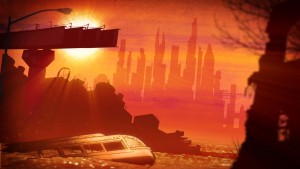 fxg: How did Guerilla FX become involved with this project?
fxg: How did Guerilla FX become involved with this project?
John: The project was actually spread out over a long period of time, and there were a couple of breaks in production, but we got involved almost a year ago, late last Summer. I’d worked with some of the producers of the show in the past at ABC News. They brought the concept to us to help them figure out a way of doing the whole thing. Initially, it wasn’t all going to be a graphic novel look, it was going to have a treated photograph aesthetic. At some point, the animated graphic novel look came in. At first, it was a very small idea of having one or two minutes of that, but then as they began to write the show they realised they wanted to have a character you could follow throughout this 100 years of time. So we were left with doing a photoreal re-creation of future events. The hokey factor is very, very high there. They were worried it would look cheesy and be too expensive. So the graphic novel concept became the main kind of animation for the show. It ended up being 35 minutes worth!
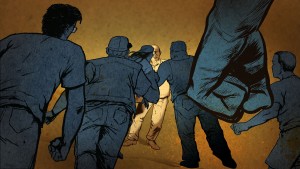 fxg: I think the graphic novel / illustration approach gives a really interesting edge to the story. How did you settle on the final look?
fxg: I think the graphic novel / illustration approach gives a really interesting edge to the story. How did you settle on the final look?
John: Illustration became a solution originally because it was an affordable way to show all these events and to depict futuristic environments and situations and characters. We looked at several illustrators and found these great guys in New York. They all worked together and had a really good style. There was an interest in having the characters have faces that people could relate to, and not go too far with an incredibly edgy or over-stylised human figure. Since we were trying to keep the people grounded in reality to some extent, then with the environments we thought it would make sense to make that really gritty. Everything around them, in terms of the textures and the choice of colour, had to reflect everything from heat to despair, rainy weather, environmental disasters and sickness. We tried to use colour to help tell the story.
fxg: To get into that story, did you start with storyboards or other planning methods?
John: Yes, definitely. ABC worked on the story for several months. As they wrote new Acts (there were 10 or 11 in the show), we would read the script and come up with suggestions for what the action could be. At that point we would storyboard how we would see the scene and send it to ABC. They would take these and cut together a board-a-matic to scratch audio at their end. They’d then send that back to us and we would do real drawings and build the whole scene in 3D space as an animatic. These were the real drawings, but not necessarily with final textures or environments, to try and get final approval on concepts, shot selections and composition. Once that was working, we’d go in and finish the scenes.
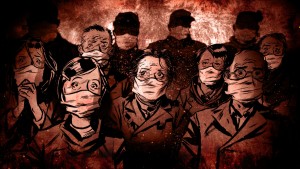 fxg: How did you create that sense of movement that’s in many of the shots?
fxg: How did you create that sense of movement that’s in many of the shots?
John: The one thing that we knew from the beginning, with a set budget, was that we couldn’t really have the characters speaking and doing sync sound with them. Plus that would have been, tone wise, a little strange for a documentary to give them voices, except for hearing the voice-over. So, if we weren’t going to have the characters talking, we knew our animations would become ‘snapshot moments’ to bring action into. We tried to build up a scene and then plan as elaborate a camera move as we could to convey the mood and show what was happening. But we still made it feel like we were moving through a moment frozen in time. Good camera work was super important from the very beginning. That was one of the main storytelling devices with the illustrations.
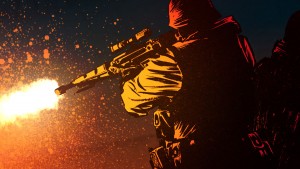 fxg:: I also noticed there’s a wide use of extra lighting in the scene, say when gun shots go off or for police lights. How did you add those in?
fxg:: I also noticed there’s a wide use of extra lighting in the scene, say when gun shots go off or for police lights. How did you add those in?
John: For the riot scene at the border, there was a pretty major use of light to try and create a lot of intensity. Since we couldn’t show action or show people bursting through the fence or actually shooting, the use of lights to show what was going on was important. We built spotlights into the scene that would probably be there in reality scanning the crowd. All of that was important to set the tone. Even in some of the simpler scenes we tried to use lighting in a dramatic way, say for a sunset or in the nighttime scenes at the hospital where it’s kind of depressing; there we used greyish, blue and dull fluorescent lighting. Anywhere we could add lighting and atmosphere into the scene, it helped flesh the scenes out.
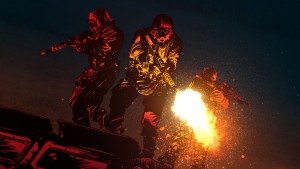 fxg: How did you put the riot scene together?
fxg: How did you put the riot scene together?
John: : We had all these great illustrations for the riot scene and it was a challenge to somehow show the intensity. That was all done with lights, spotlights and shadows and highlighting the crowd. The great thing about that was being able to set up the scene with tons of people and then playing with the lights. We got lots of happy surprises, like when shadows would fall on people’s faces and look really creepy. The flashing red and blue lights also made for some great dramatic moments. Once the technique was set up, each shot almost built itself.
movielink(09Jul/earth/Earth-Riot_Small.mov, click here to watch the Riot clip)
fxg: What tools did you use for the production of the shots?
John: Mostly After Effects, 3ds Max and plenty of Photoshop.
fxg: Were there any live-action elements used?
John: Mostly, no, but we did use some photographs to help build the environments. That was always the plan from the beginning. It’s very faithful to the graphic novel style to use actual photographs and marry them with drawings and actually draw on photographs a little bit. We used some stock footage for a few of the fires. We also relied on the ABC News’ library which has tons and tons of good footage, which we sometimes incorporated into shots. We built up libraries of smoke, clouds and dust to be seen moving through the scenes, like in the caravan convoy. So there were a bunch of CG creations or pieces of stock footage.
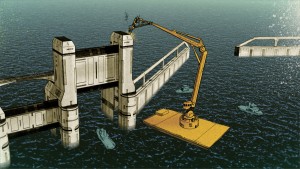 fxg: Can you break down the sea wall scene for me?
fxg: Can you break down the sea wall scene for me?
John: That’s a scene that was treated pretty heavily in 3ds Max. We were originally going to show the sea wall in the same way as the other animation, which was to just draw it from five or six different angles. Then, because of the time it would have taken to draw those and because of the limited camera moves, we decided to build a simple 3D model of the sea wall instead. That was built first to plan out the shot. I took this model and unwrapped it and gave the illustrators a template to draw on. So I’d show them the front face and then the side of a particular tower, say. I gave them a layout grid that they could then draw all the cool details you see onto. Once they were done, I could scan in their artwork and remap it onto the scene. So it still looked drawn but was also now extremely dimensional. The camera could fly around it and that let us put in the water.
The water is a simulation done in 3ds Max, but instead of rendering it realistically in any way, it has a fake illustrated type of texture put onto it which makes it very high contrast. It needed to blend in with the drawing style – the black and white nature of the water mixes with the drawings. The rain is all done in Particular in After Effects, which is a third party plugin by Trapcode. The scene had 3D cameras which we set up in Max that we then imported into After Effects, which worked really well with Particular. It all looked like it was done in the same program.
movielink(09Jul/earth/Earth-NYC_Sea_Wall_Small.mov, click here to watch the Sea wall clip)
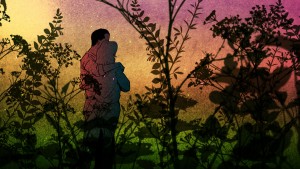 fxg: It’s great to see a different method used to absorb the story.
fxg: It’s great to see a different method used to absorb the story.
John: Yeah, one thing I also have to say is that everyone on the show had a great time, even with the really tight deadline. In addition to being kind of cool, it’s a very fun technique to work on. Designer animators just loved it because they could go through scenes relatively quickly. It didn’t have to be photo-real. They just get in there, set up the camera and start designing. The amount of creativity each person had was tremendous and people really seemed to enjoy working on it. When it was over, even though I was basically sleeping here for the last few nights, it was kind of depressing because I just wanted to do more of it!
Credit Roll
DIRECTOR OF ANIMATION
John Bair
EXECUTIVE PRODUCER
Vivian Connolly
PRODUCER
Renuka Ballal
DESIGNERS
Yorgo Alexopoulos
Christian Lowe
Dana Schechter
Molly Schwartz
ANIMATORS
Brian Haimes
Sean Kim
Amber Kusmenko
Aaron Raff
ILLUSTRATORS
Tim Hamilton
Joe Infurnari
George O’Connor
Leland Purvis
ABC EXECS
Michael Bicks (Executive Producer)
Rudy Bednar (Senior Executive Producer/Director)
